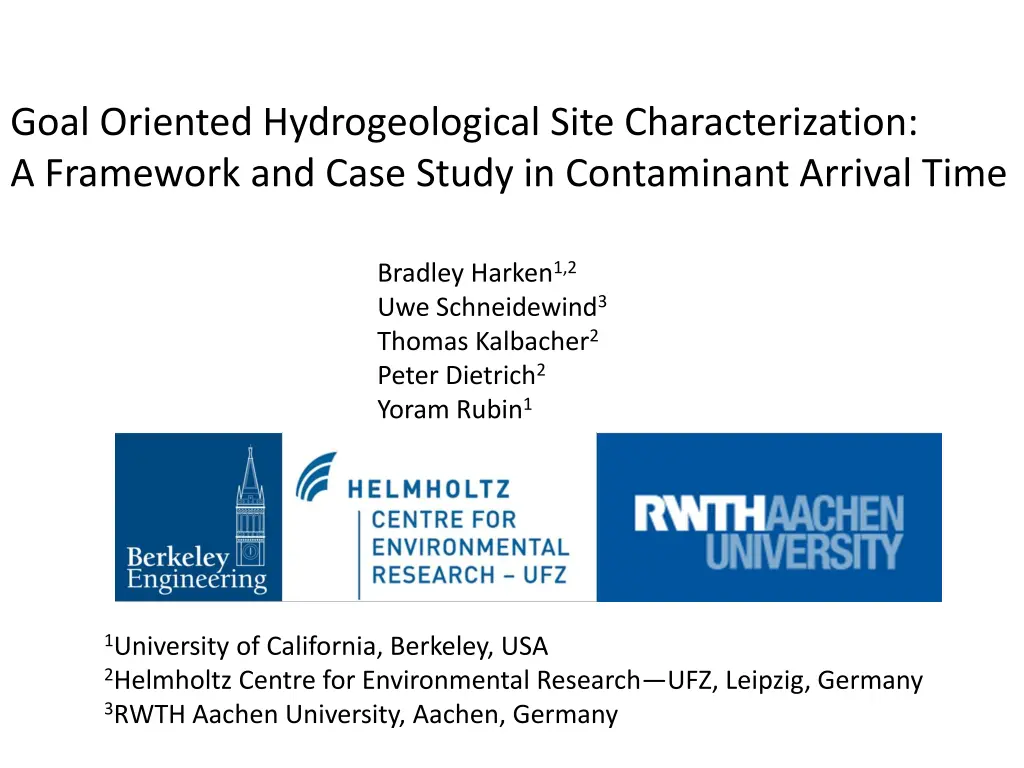
Effective Strategies for Hydrogeological Site Characterization
Explore a comprehensive framework for hydrogeological site characterization, encompassing groundwater contamination, uncertainty in models, hypothesis testing, and the role of field data. Learn how to address uncertainties, make informed decisions, and optimize field campaigns to reduce risks effectively.
Download Presentation

Please find below an Image/Link to download the presentation.
The content on the website is provided AS IS for your information and personal use only. It may not be sold, licensed, or shared on other websites without obtaining consent from the author. If you encounter any issues during the download, it is possible that the publisher has removed the file from their server.
You are allowed to download the files provided on this website for personal or commercial use, subject to the condition that they are used lawfully. All files are the property of their respective owners.
The content on the website is provided AS IS for your information and personal use only. It may not be sold, licensed, or shared on other websites without obtaining consent from the author.
E N D
Presentation Transcript
Goal Oriented Hydrogeological Site Characterization: A Framework and Case Study in Contaminant Arrival Time Bradley Harken1,2 Uwe Schneidewind3 Thomas Kalbacher2 Peter Dietrich2 Yoram Rubin1 1University of California, Berkeley, USA 2Helmholtz Centre for Environmental Research UFZ, Leipzig, Germany 3RWTH Aachen University, Aachen, Germany
Groundwater Contamination http://www.huffingtonpost.com/2013/01/12/tap-water-catches-fire-methane- debby-jason-kline_n_2462981.html Prevention, Regulation, Risk Assessment, Remediation Will maximum concentration exceed Maximum Contaminant Levels? Will a plume reach water supplies before it degrades? Is a waste disposal site safe? Use hydrogeological models to answer these questions How to cope with uncertainty?
Uncertainty in Hydrogeological Models Conceptual model uncertainty Uncertainty in parameters Difficulty in characterization Determination of necessary parameters (e.g. Hydraulic Conductivity) Description of spatial variability of parameters (mean, drift, covariance structure, ) Costs and logistics of field campaigns Measurement Errors How to account for this uncertainty while answering questions relevant to remediation, regulation, risk assessment, etc.? Decisions often made by non-hydrologists
Hypothesis Testing Framework Modeling Predictions: Hypotheses, amenable to statistical treatment Null Hypothesis (?0): dangerous scenario, fallback assumption Example: contaminant arrives at water supply before it degrades Alternative Hypothesis (??): desirable scenario, requires convincing evidence water supply is safe from contamination Possible Errors: Type I (?) Error: Accidentally expose population to contaminants Type II (?) Error: Unnecessarily find alternative supply Account for all uncertainty in a simple, easy to understand manner Enable risk-based decision making Subjectively defined accepted level of uncertainty
Role of Field Data More field data less uncertainty Different field campaign designs result in different levels of uncertainty Field campaign design: specifies quantity, type, and spatial location of field measurements Which design will best meet uncertainty requirements, subject to other constraints? Cost Field Logistics
Forward Modeling Characterization Decision Making Prior Parameter Estimates Modeling Predictions Information Field Data Water resources management, policy, or regulation decision Modeling Predictions (e.g. ?, ????) UNCERTAINTY Inverse Modeling Find new water source? UNCERTAINTY Parameter Estimates (e.g. K) Remediate contaminated site? UNCERTAINTY Hypothesis Testing: allows us to account for all sources of uncertainty in a simple, easy to communicate manner Enables us to examine the link between field data and uncertainty in decisions
Hypothesis Testing: Summary Allows us to make risk-based, defensible decisions in face of uncertainty Easily communicate uncertainty to decision-makers (not hydrologists) Next: use HT framework to optimize field campaign designs in order to best support decision-making
Use HT Framework to Assess Field Campaign Design Baseline field simulated according to prior knowledge ?0 or ?? true? Simulate Baseline Field Baseline Field Baseline Field Baseline Field Baseline Field Simulate Simulate Simulate Simulate Physical models with baseline field synthetic truth Simulate Field Campaign Data collected from baseline field according to field campaign design Simulate fields conditional only to collected data Conditional Simulations Simulate decision making Would we have made the correct decision? Correct? ? Error? ? Error? ? Error? ? Error? ? Error? Accept or Reject ?0 Correct? ? Error? ? Error? ? Error? ? Error? ? Error? Correct? Correct? Correct? Repeat on numerous baseline fields Pr[? ?????] & Pr[? ?????]
Synthetic Case Study Issue alert if contaminant will arrive at target before a critical amount of time passes Budget allows for 8 measurements of hydraulic conductivity Measurements used for: Estimation of geostatistical parameters Conditioning values in forward model What is the best spatial configuration of measurements?
Measurements: Possible Spatial Configurations Option 1: Spread measurements throughout domain for improved estimate of geostatistical parameters and global trends Alternatively, focus on travel path for stronger conditioning Option 2: Spread along whole path Option 3: Clustered close to source Option 4: Clustered close to target
Results ??= Pr ? ????? = Pr[??????? ?????? ??????] ?????= 230? ?????= 350? This is when ?????= 350 ?. What if ????? was smaller? Conclusion: Best spatial configuration of measurements depends on how early are the early arrivals we re trying to predict
Summary Hypothesis Testing enables risk-based decision making in face of uncertainty Better communicate relationship between uncertainty in data, parameters, models, etc. and uncertainty in questions we ultimately want to answer Improve link between hydrologists and managers/regulators Hypothesis Testing allows us to optimize our data collection Uncertainty in final prediction as quantitative measure of data effectiveness
THANK YOU! References: Nowak, W., Y. Rubin, and F. P. J. de Barros (2012), A hypothesis-driven approach to optimize field campaigns, Water Resour. Res., 48, W06509, doi:10.1029/2011WR011016. Nowak, W., F. P. J. de Barros, and Y. Rubin (2010), Bayesian geostatistical design: Task driven optimal site investigation when the geostatistical model is uncertain, Water Resour. Res., 46, W03535, doi:10.1029/2009WR008312.
